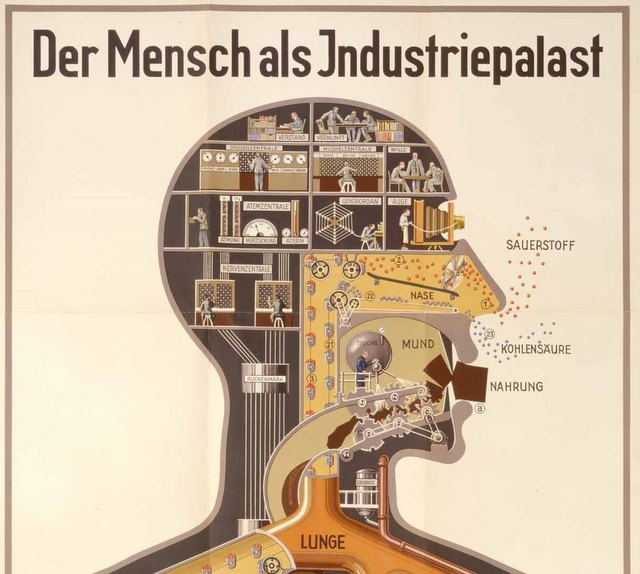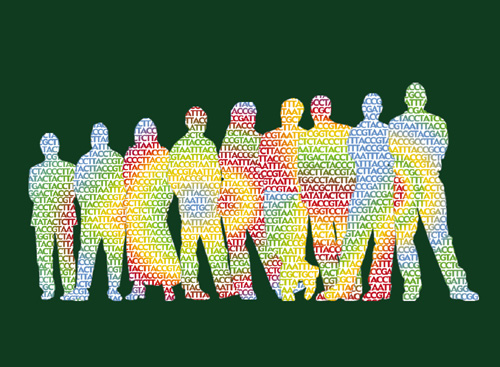Self-tracking: Checking under the hood

Der Mensch als Industriepalast (Man as Industrial Palace), Fritz Kahn, 1926. (See full description below.)
Our bodies are exquisite self-tracking machines. We’re artfully engineered with rheostats and feedback loops and switches. The number of times our heart beats in a minute, the temperature of our body, the pH of our blood, the sodium concentration inside our cells, and the turning on and off of our genes are all tightly regulated.
Unfortunately, we don’t come equipped with external tachometers. We don’t have a fuel gauge that points a needle to ‘full’ to signify when we should stop eating, or a temperature gauge to indicate when we are overheating. There is no factory-installed ‘check engine’ light.
In order to make sense of what’s going on under our hoods, we can turn to a variety of tracking tools. Sensors, probes and analyzers help us detect the electrical, chemical and mechanical signals emanating from within. We can measure, track and display with respect to time and space, episode and intervention. And best of all, we get to serve as our own control: N=1.
From lab bench to park bench
As a physiologist, my life has revolved around self-tracking. In grad school, we routinely used ourselves to calibrate equipment, develop techniques, and generally see ‘what would happen if….’ We documented our lives in lab notebooks and every day was ‘show and tell.’
Self-tracking is moving out of the lab and into living rooms and bedrooms, gyms and diners. There’s a rapidly growing community, Quantified Self, that is “a collaboration of users and tool makers who share an interest in self-knowledge through self-tracking.” The site originated with gurus Kevin Kelly and Gary Wolf, and an expanding community is overseen by them, along with Alexandra Carmichael, cofounder of CureTogether. There are more than a dozen meet-up groups around the world, as well as an active Twitter community (#quantifiedself).
Long the province of elite athletes and astronauts at one end of the spectrum, and individuals living with chronic diseases (and ICU patients) at the other end of the spectrum, tracking is moving from the fringes inward. Now the bright, shiny gadgets we ordered from scientific equipment catalogs (lactate analyzers, heart rate monitors, pulse oximeters) can be picked up on Amazon.
Should you check under your hood?
Suffering from insomnia? Want to get pregnant? Training for your first 10K? Measuring any number of parameters can reveal trends and provide clues as to what makes you tick. Self-tracking can help you make a connection between what you’re feeling or sensing and how your body is doing.
You can track physiological parameters such as heart rate, blood pressure, body temperature, and blood glucose. You can track mental health parameters such as mood and self-esteem. You can track behaviors such as foods eaten, hours spent sitting at a computer, songs listened to, minutes spent exercising, and hours spent sleeping. You can track environmental influences such as outside temperature and pollen count, commuting time, number of friends on Facebook, number of neighbors on your street you know by first name.
The data provide a glimpse of what’s going on under your hood. The measures are all exquisitely intertwined and although they might not represent true cause and effect, when grouped in combination they can reveal wonderful patterns. The patterns tell a story that can provide you with insights and awareness, which may in turn lead to behavior change, thus creating a feedback loop much like your internal circuits.
Self-tracking lets you build a personal dashboard to create a narrative of yourself. It can empower you to better understand how you are functioning, and thereby put you in better control of what’s going on under your hood. And as you self-track, at some point you will cross a threshold where you view your body not only as a machine full of data points, but as an engineered piece of living art.
Great self-tracking resources
- Quantified Self
- What if Self-Tracking Goes Mainstream?, Alexandra Carmichael, The Future Now Blog
- The data-driven life, Gary Wolf, The New York Times
- Know thyself: Tracking every facet of life, from sleep to mood to pain, 24/7/365, Gary Wolf, Wired
Related posts
- Self-tracking, Sensors, and mHealth: Trends and Opportunities
- Self-Tracking Meets Ready-To-Wear: Make Room in Your Closet for Smart Clothes
- mHealth: Health where you live, work, and play
- Twelve Everyday Health Rules–From 1908
- Are humans designed to be endurance runners?
The image
The image above is a cropped view of Der Mensch als Industriepalast (Man as Industrial Palace) by Fritz Kahn (1888-1968). It is a chromolithograph frpm 1926, and is courtesy of the National Library of Medicine, as part of their amazing Dream Anatomy exhibit. “Kahn’s modernist visualization of the digestive and respiratory system as ‘industrial palace,’ really a chemical plant, was conceived in a period when the German chemical industry was the world’s most advanced.”
Inspired by the art, Henning M. Lederer created this video in 2009:









Hi,
Just wondering if you’ve come across any resources detailing ways to get deeper into “tracking the body” using the body itself? External tools are useful, but limited to their application, and take away responsibility and sensitivity from the user, who begins to rely on the tool, rather than learn the process themselves…
Interested to hear your feedback!
Thanks!
Josh
Thanks so much for the shoutout, Carol!
Alex 🙂
[…] Self-tracking: Checking under the hood […]
[…] Self-tracking: Checking under the hood […]
[…] Self-tracking: Checking under the hood […]
[…] Self-tracking: Checking under the hood […]
[…] Self-tracking: Checking under the hood […]
[…] Self-tracking: Checking under the hood […]
[…] Self-tracking: Checking under the hood […]